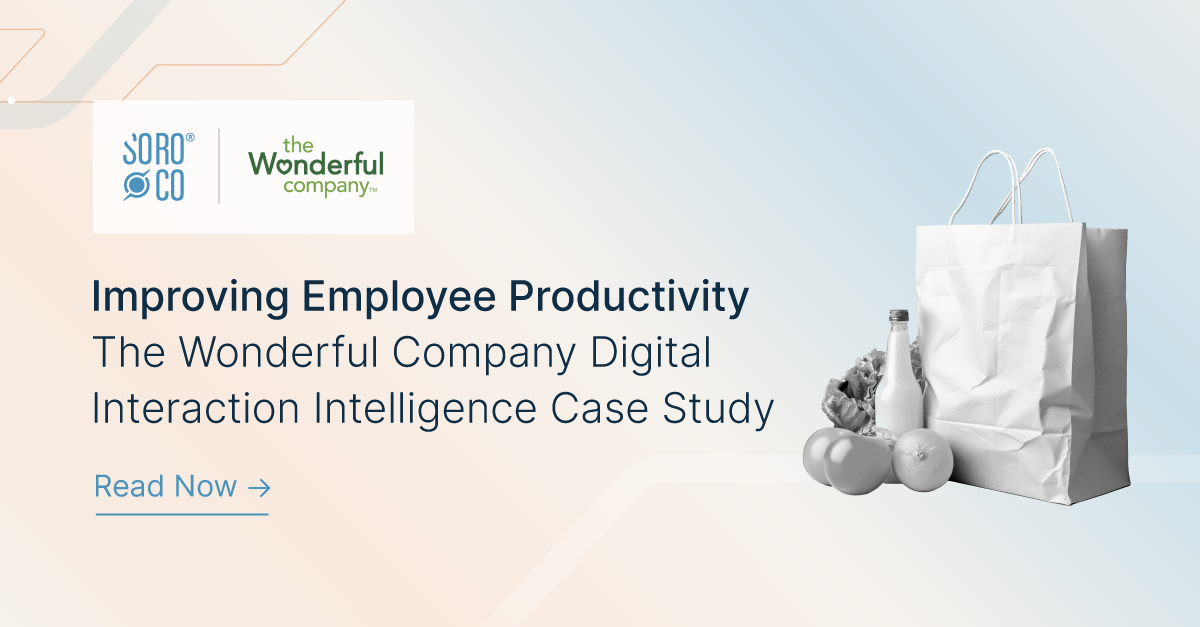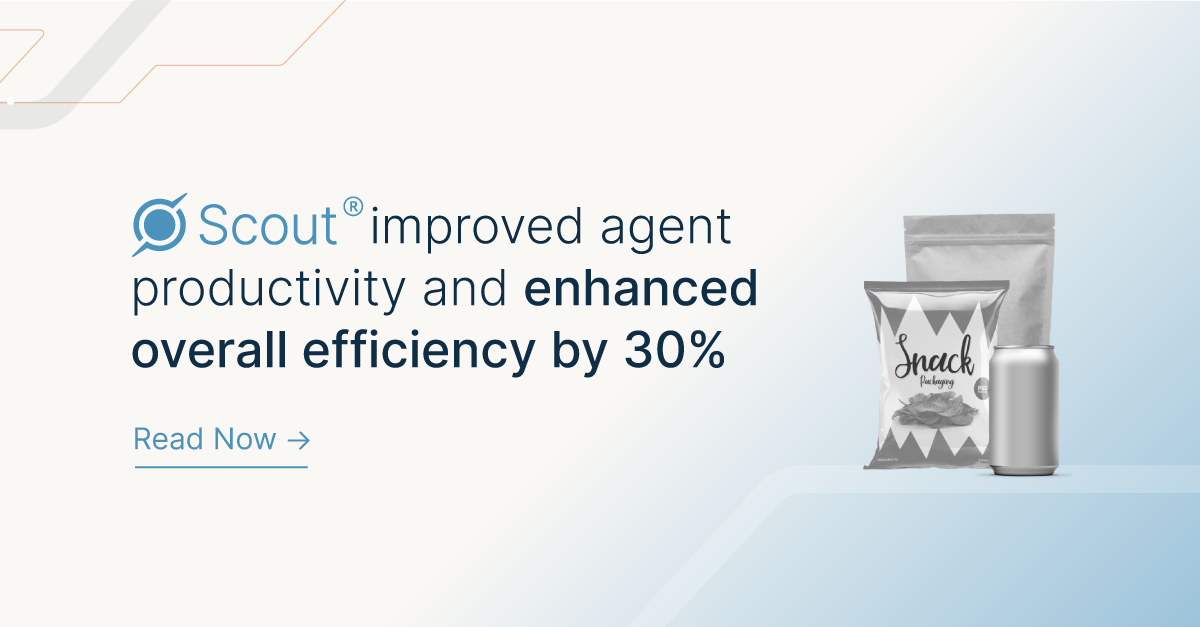FMCG The Wonderful Company discovers 12000 hours of process improvement benefits in order processing and shipping processes with Scout Published by Everest Group for Soroco: Read here Enterprise overview Lynda and Stewart Resnick co-founded The Wonderful Company, a privately held US $5 billion global corporation that’s dedicated to delivering high-quality, healthy brands and improving the lives of the people who live and work in the regions where it operates. Its iconic brands include FIJI Water, POM Wonderful, Wonderful Pistachios, Wonderful Halos, Wonderful Seedless Lemons, Teleflora, and JUSTIN and Landmark wines. The Wonderful Company’s diverse holdings make it the world’s leading grower of tree nuts, America’s largest citrus grower, and the world’s largest flower delivery service. It is also a market leader in wines, bottled water, and pomegranate juice. Headquartered in Los Angeles, with major operations in California’s Central Valley and Fiji, its 10,000-person workforce is passionate about building a better world. In pursuit of this mission, the company has partnered with Soroco to utilize its digital interaction intelligence solutions to further optimize its internal processes. Industry FMCG Employees 10000 Headquarters Los Angeles Drivers of adoption Scale automation Leverage task mining to identify and prioritize automation opportunities across the organization. Continuous process improvement Adopt a fact-based approach to discover and analyze processes to continuously improve overall process efficiencies. Improve employee productivity Enable employees to realize their scope and potential for improving task execution. Approach to DII initiatives Project initiation A Digital Interaction Intelligence pilot project was introduced in 2022 to understand the impact on hours saved to perform different operations. Process selection Major stakeholders involved in process selection for deploying these solutions were the business, automation, continuous improvement, and IT project teams. Talent Wonderful leveraged Soroco to train its internal teams and to obtain solutions to queries surrounding various technology aspects. Organization structure While Wonderful has dedicated teams for continuous improvement initiatives, it also leverages Soroco stakeholders as needed to help implement task mining projects. Its digital transformation team is responsible for securing the budget for these initiatives. Strategic Payoff ~12000hrs of potential process improvement benefits discovered as a result of successfully implemented digital interaction intelligence for multiple processes. ~75% of the insights derived were converted into actionable items and leveraged in use cases. Status of these initiatives Current status 2 projects that involved order entry and closing process and shipping process have Digital interaction intelligence underway 15 users is now the scale of deployment with rotational licenses. 60+ use cases identified by Wonderful, using task mining or digital interaction intelligence solutions. Future plans Aim to enable continuous improvement across processes so that other teams can also start working independently.Continue to leverage digital interaction intelligence to identify more use cases across multiple projects.Expand the reach of the technology across different teams and deployments and ensure enhanced employee and customer experience through these initiatives. Challenges Addressing concerns from operational teams regarding the adoption of task mining / DII technology due to the apprehensions around increased visibility and transparency into the ways of working Lack of understanding about the applications and benefits that DII technology could offer Getting approvals from the IT team related to data usage in the initial phase of the journey Key Takeaways The team leading these initiatives needs to be present on the ground to help users gain exposure to technology and address their queries in real-time. Have an effective change management program in place to align with different stakeholders. This is crucial to secure executive sponsorship and buy-in and to establish proper communication channels. Gain deeper process understanding or leverage process SMEs to perform the analysis to identify relevant insights and improvement opportunities. Build highly collaborative cross-functional relationships to accelerate the delivery speed following these initiatives. To get more insights about Digital Interaction Intelligence and download the complete DII playbook by Everest Group Download the Everest Group Playbook
Category: fmcg
FMCG company use case solved by soroco
FMCG Scout improved agent productivity and enhanced overall efficiency by 30% for a global beverage producer Email it to me The Challenge A global Fortune 500 beverage manufacturer with 100+ brands, 15+ recent acquisitions faced unexpected operational inefficiencies in order processing, leading to delays, errors, and ultimately, a jeopardized customer experience and lost sales. Despite investments in top-tier CRM and Order Management systems, the order management teams were struggling with high attrition, low morale, and an inability to meet business outcomes, putting the company at risk of significant reputational harm and revenue challenges. Location Global Industry FMCG 100+ Brands 15+ Acquisitions Attempted Solution before Scout Team requested for an additional 1,400 hours for Manual Discovery Workshops The Leadership mandated their internal Digital Transformation team along with their System Integrator to rectify the situation, who undertook a two-pronged approach. They deployed a process mining solution and attempted manual ‘discovery workshops’ to understand team workflows. However, these methods proved time-consuming as they requested 1400 hours from business teams to complete these discovery workshops. These teams were also working out of different locations across the globe, which added to the complexity. This turned out stressful for the already overburdened teams, and ultimately failed to provide the holistic insights needed. Enter In response to the ongoing issues, the Head of Customer Experience and the Head of Automation introduced Scout to find and fix the problem. Scout’s AI model could be quickly put into action across 7 teams in 12 countries, because it didn’t need complicated integration with current systems. The AI analyzed how operations management teams navigated across various applications, mapping out how and why work happens the way it does within the entire order management function. Scout’s AI model could be quickly put into action across 7 teams in 12 countries, because it didn’t need complicated integration with current systems. Scout to “find and fix” Step 1: Find As the first step, the AI decoded the work patterns of the order management team and connected them with business activities, by analyzing interactions between the team and their software. It then automatically classified these work patterns as either core order management activities or non-core activities. Based on this analysis, within two weeks, Scout’s AI model provided the following insights: 30% time was spent on core Operations Management and CRM applications Contrary to existing assumptions, the analysis revealed that only 30% of the team’s time was spent on core Operations Management and CRM applications. This startling statistic pointed to a massive work recall gap across the team, highlighting the disparity between the team’s understanding of how work is being done and how work was actually being done. Harvard Business Review Do You Know How Your Teams Get Work Done? Read article 70% time was spent on manual tasks The AI also determined that the remaining 70% of the time was spent in manual tasks like email communications, spreadsheet management, and report creation. This high volume of manual work led to errors and delays, exacerbated by significant variations in order processing across different brand teams. Scout’s AI model then further inferred the reason why the order management team spent so much time on non-core activities – information silos and disconnected systems. These bottlenecks were forcing the team to incessantly toggle between different applications, ultimately resulting in a loss of productivity for all the brand teams. Harvard Business Review How Much Time Does Having Too Many Apps Really Waste? Read article Step 2: Fix Based on the above insights, Scout’s AI model recommended two levels of fixes: Quick Fixes These were ‘no-code’ fixes based on standardization and user training Provide focused training on existing Order Management – CRM system to improve adoption Provide focused training on existing Order Management – CRM system to improve adoption Leadership realized that order management teams and customers were accustomed to the business-as-usual ways of working over emails. Thus, they initiated a targeted awareness campaign for the OM – CRM system, aimed at familiarizing customers and order management teams with the new features and benefits of the system. This effort helped increase system adoption and reduce bespoke manual activities. Improve self-service capabilities for customers: Improve self-service capabilities for customers: Post the awareness campaign, management’s goal was to empower customers with more control over their orders. To achieve this, customers were provided with tools and training to place orders, make changes to orders, track the status of their orders, and have real time visibility into the order process. Standardization of management reporting: Standardization of management reporting: Leadership realized that they were part of the problem by insisting on several customized reports. They recognized that the customized reports required time investment and decided to standardize and automate them, allowing them to focus more on upselling and cross-selling activities Deep Fixes Systemic and long-term fixes planned across the organization Scout also provided detailed insights into the cost of unintegrated order management systems and, also the disconnection debt in the organisation. Based on these insights the leadership kicked off a digital transformation program to Create an end-to-end workflow system integrating information inputs, information validation, business process rules, transaction processing & reporting, and compliance. Study variations across how teams worked, standardized, and optimized processes. Automate various functions like time-consuming manual validations in data maintenance activities such as contract activation, inactivation, and rebate settlement across different automation technologies like IDP, RPA, chatbots, etc. Harvard Business Review What’s Lost When Data Systems Don’t Communicate Read article It is important to note that in all of these recommendations, privacy was of the utmost importance – and no employee data was shared. Empathy was at the core of all recommendations and the focus was on addressing and improving the core issues i.e. Getting teams to work together across functions Fixing disconnected systems Simplifying and optimizing work processes Strategic Payoff The strategic implementation of Scout’s recommendations led to: 25% Reduction in Delays and Errors: In order processing. 30% Improvement in Agent Productivity: Enhancing overall efficiency. 10% Improvement in Cash Flows: Reflecting… Continue reading FMCG company use case solved by soroco

